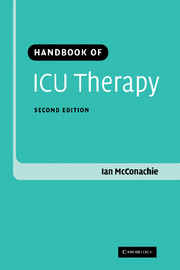Book contents
- Frontmatter
- Contents
- List of contributors
- Preface
- Part I Basic principles
- 1 Cardiac function, monitoring, oxygen transport
- 2 Shock
- 3 Oxygen therapy
- 4 Central venous access
- 5 Fluid therapy in ICU
- 6 Anaemia and blood transfusion
- 7 Nutrition
- 8 Non-invasive mechanical ventilation
- 9 Principles of IPPV
- 10 Modes of ventilation and ventilatory strategies
- 11 Weaning and tracheostomy
- 12 Vasoactive drugs
- 13 Infection and infection control
- 14 Sedation, analgesia and neuromuscular blockade
- 15 Continuous renal replacement therapy
- 16 Withholding and withdrawing therapy in the ICU
- Part II Specific problems
- Index
9 - Principles of IPPV
Published online by Cambridge University Press: 24 August 2009
- Frontmatter
- Contents
- List of contributors
- Preface
- Part I Basic principles
- 1 Cardiac function, monitoring, oxygen transport
- 2 Shock
- 3 Oxygen therapy
- 4 Central venous access
- 5 Fluid therapy in ICU
- 6 Anaemia and blood transfusion
- 7 Nutrition
- 8 Non-invasive mechanical ventilation
- 9 Principles of IPPV
- 10 Modes of ventilation and ventilatory strategies
- 11 Weaning and tracheostomy
- 12 Vasoactive drugs
- 13 Infection and infection control
- 14 Sedation, analgesia and neuromuscular blockade
- 15 Continuous renal replacement therapy
- 16 Withholding and withdrawing therapy in the ICU
- Part II Specific problems
- Index
Summary
Mechanical ventilation, especially intermittent positive pressure ventilation (IPPV) is the mainstay of modern intensive care practice and of fundamental importance to intensive care unit (ICU) therapy.
Care of the ventilated patient
General issues
Airway. Access via cuffed tracheal tube or tracheostomy. Secure the tube. Do not overinflate the tracheal cuff. Cuff pressure should be regularly measured, even in tubes with a high-volume/low-pressure cuff.
Provide adequate humidification and clearance of secretions. The absence of humidification will encourage heat loss and dehydration of the upper respiratory tract. This can cause upper airway epithelial damage, and difficulties with clearance of dry secretions. Conversely, excess heat and/or humidification can cause problems.
Routine nursing care including care of the unconscious patient.
Monitor appropriately. In view of the unpredictable and complex effects of IPPV on the circulation be prepared to monitor the central vascular pressures and cardiac output (CO). An arterial line is mandatory to facilitate blood gas sampling for all but the shortest periods of ventilation.
Nasogastric (N/G) tube to relieve gastric distension and permit administration of medications and nutrition.
Ensure patient comfort as far as possible. See Chapter 14, Sedation, Analgesia and Neuromuscular Blockade.
Ensure adequate nutrition and hydration.
Specific issues
Deep vein thrombosis prevention
Deep vein thrombosis (DVT) is common among patients requiring prolonged mechanical ventilation in the ICU setting despite the use of prophylaxis measures.
- Type
- Chapter
- Information
- Handbook of ICU Therapy , pp. 105 - 121Publisher: Cambridge University PressPrint publication year: 2006



